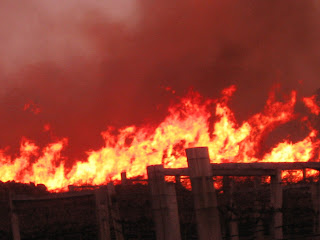Here, as in many farming districts in Australia, a controlled burn-off is a necessary part of farming.
After the wet summer we had, the growth of grasses was rapid and prolific.
Then came winter with its cold weather and early morning frosts, killing off all the grass. Where it was once lush green land was now brown and dry. A veritable tinder box.
The photo above shows a section of our property, all brown and dry.
The dead vegetation becomes a fuel-load for the farm, and if a bushfire went through it would burn ferociously. So burn-offs are absolutely necessary.
Burn-offs are not done lightly.
Permission must be obtained from the Rural Fire Brigade.
Fire breaks must be made.
Extra helping hands must be asked to attend.
Then, taking the weather conditions into account,(e.g.it can't be windy) the fire is started.
It is usually done in the late afternoon, and I find it exciting to watch, and hear, and smell.
The flames are so bright, and the fire roars as it progresses. And the smell always reminds me of sitting around campfires....wonderful memories evoked by the burn-offs.
However, from a controlled burn-off, I can also appreciate how a huge bushfire could be absolutely terrifying. The sight and sounds would be frightening.
The photos below are of a controlled burn-off in a neighbour's property two weeks ago.
At night, the embers still glow.
The next day the land is black,and the dead vegetation, the fire hazard, has gone.
With the next shower of rain the burnt remains are recycled into the ground.
Not quite a slash-and-burn economy, but a very good imitation of methods used for millenia.





Great photos Frances! Makes you appreciate how terrifying it would be to be in the midst of a real bushfire.
ReplyDeleteThanks Fiona.
ReplyDeleteYes, it would be terrifying.
Mario burnt off yesterday, and our turn is coming next week.
We have to do it, but we're always glad when it's over.
Frances